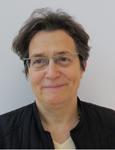Systems for Abstraction is an exhibition at the James Watrous Gallery featuring three Wisconsin artists who use abstraction as a way to organize and present their views of the world. The work of Jill Olm, Beth Racette, and Leslie Vansen builds on the work of earlier artists in the Abstract Expressionist and Color Field movements of the twentieth century.
Whereas Abstract Expressionists were interested in the materials and physical process of painting, regarding the finished painting as an “object” which recorded the artist’s struggle to create, these three artists turn their conversation with abstraction toward the exploration of systems. While Olm, Racette, and Vansen are each deeply interested in the formal elements of composition and color, they are also interested in synthesizing information gathered from fields beyond the visual arts.
Madison artist Beth Racette studies the theory of Gaia, which conceptualizes Earth as a self-regulating, complex living system with the capacity to maintain the conditions of life. “My aim is to learn about the many systems and aspects of Gaia—biosphere, technosphere, and noösphere—and to synthesize my findings visually,” says Racette.
Do you consider yourself an abstract artist, or are you a visual artist with a specific body of abstract work? What role does your chosen media play in making this distinction?
 I work in many media and styles, so I don’t consider myself an abstract artist. When I make art, my goal is to involve and integrate my entire mind, body, and spirit.
I work in many media and styles, so I don’t consider myself an abstract artist. When I make art, my goal is to involve and integrate my entire mind, body, and spirit.
My abstract painting is a contemplative and improvisational practice. I develop my own visual language as a means to explore my internal landscape and external world. For most of my art-making career, painting has been a private process in which I try to untangle the complex overwhelm of life, world, and mind.
My installations have been intentionally created for an audience. In installation work I utilize found and existing objects—often societal or natural debris—loaded with cultural context and connotations. Through this familiarity of objects, I aim to give the audience visual poems that explore human constructs and evolution. In contrast to the private process of my earlier paintings, with this James Watrous Gallery exhibition I intend to bring my painted explorations to a larger audience.
Your work seems to reference discrete systems. How do you communicate or suggest these elements to viewers? What role does science or social science play in informing your work?
 My paintings reference process and relationships more than data and quantifiable structure. I explore patterns of flow and interconnections of self, history, biology, contagion, and communication. This exploration is simultaneously micro- and macroscopic. Cells within the paintings can represent a biological cell, an organ, an organism, a super-organism, and an institution.
My paintings reference process and relationships more than data and quantifiable structure. I explore patterns of flow and interconnections of self, history, biology, contagion, and communication. This exploration is simultaneously micro- and macroscopic. Cells within the paintings can represent a biological cell, an organ, an organism, a super-organism, and an institution.
Systems theory is an exciting scientific area. It focuses on the processes and properties that organize life. These properties are seen across various scales of systems, from atomic to galactic. Living systems constantly respond, grow, change and adapt, and they move towards complexity.
At the Watrous Gallery, I will exhibit a series of paintings that explore Gaia, the theory that Earth is a self-regulating and complex living system with the capacity to maintain the conditions for life. My aim is to learn about the many systems and aspects of Gaia: biosphere, noösphere, technosphere, evolutionary patterns, geological formations, and systems of flow. I also want to be aware of the current destruction of the biosphere, which is escalating exponentially. Hopefully with mindfulness of Gaia we can interrupt our own destructive patterns.
Abstract art is enjoying a resurgence in Wisconsin and across America right now. Do you feel allied to particular artists past or present?

I’m informed by many different types of visual art, other creative fields as well as direct experience of the earth. I aim to ally myself with all artists. My interests vary widely and there is so much innovation by which I’m inspired and informed—it can be overwhelming. In abstract painting, one of my favorite local painters is Teresa Getty. Lately I’ve looked at the paintings of Julie Mehretu, Alexis Avlamis and Sienna Shields. I’m currently viewing documentary films and images of earth. A fun book is Visual Complexity: Mapping Patterns of Information by Manuel Lima. Science writers also inform my work: Bill McKibben’s Eaarth: Making a Life on a Tough New Planet is particularly eye opening.
The new creation story inspires me, too. In this evolutionary long view, science and spiritual traditions inform each other and humans belong within an evolving universe interdependent with all life. This is in strict contrast to prominent religious and scientific mythology where humans arrogantly and rudely place ourselves at the top of a hierarchy.
In my art, whether in painting or installation, I always want to cast a wide net of exploration, learn as much as I can, and visually synthesize my findings.




